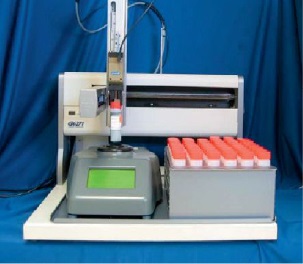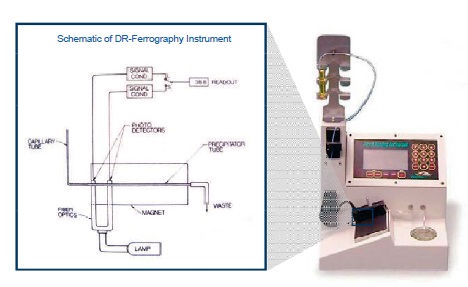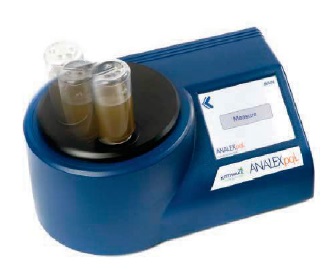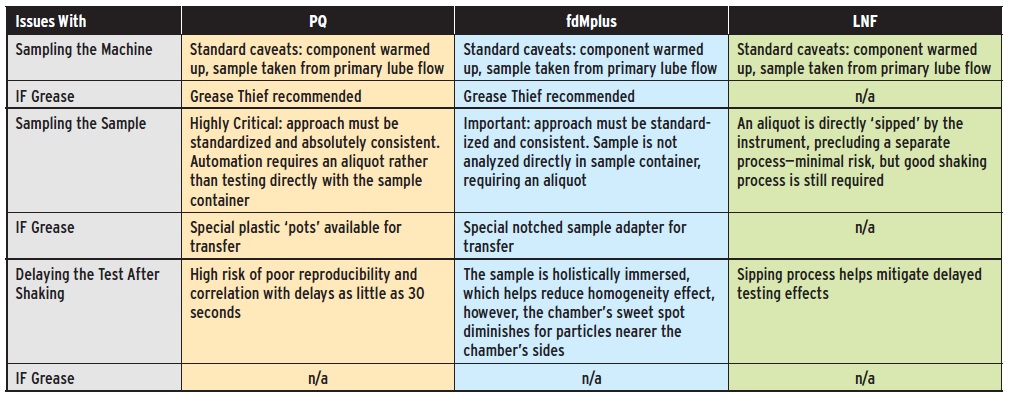Complexity in ISFA (in-service fluid analysis): Part XV
Jack Poley | TLT On Condition Monitoring March 2014
Revisiting the sampling/handling conundrum.
WE DISCUSSED SOME OF THE CONFLICTS encountered with respect to particle inspection and looked at several types of instruments, as well as all three tiers of ISFA in the January TLT.
I now want to add the notions of sampling and the interplay of sample handling as to efficacy and results, regarding particles, as these aspects are critical as often as not.
Ignoring proper account setup steps, which many do, ISFA begins with the collection of a sample, ostensibly a sample that is representative of the resident circulating fluid. One then chants the ISFA domain expert admonishment, “Ensure that a representative sample is secured from the fluid circuit.” This is vital, to be sure, but I also want to bring the notion of sample handling into the discussion once the sample is in the laboratory, because this is equally important to achieving a best-case result. (i.e., the most accurate result that might be expected based on, say, an ASTM method or practice.)
Let’s back up a bit and discuss what might be expected to be best case, prior to when the process of sampling even occurs. Let’s be sure we understand that there are numbers of things that can occur in the sampling processes. Ignoring semantics for now, there are two samples for most tests: (1.) The collecting of a sample and (2.) The aliquot taken from the sample container at time of testing, i.e., the sampling of the sample.
STANDARD DIAMETRIC PARTICLE COUNT
There are varieties of instruments and methods to achieve an indicative result, dependent on the contamination in, and the characteristics of, the fluid tested. Diametric particle counters, including one aspect of the LaserNet- Fines (LNF) results output, each have the preferred requirement that a sample be thoroughly shaken prior to analysis, preferably by machine and timed-shaking cycle, then analyzed very shortly after the shaking cycle to reap the benefit of the shaking.
There are numbers of opportunities to stray from a routine, the biggest being the delay in getting the freshly shaken sample to the analyzer. The LNF can, and does, analyze straight from the sample container received from the customer, but that will not occur with other counters, where a sample transfer is necessary. One can relate to the notion of different analyzers and different procedures such that it could be difficult to get results agreement. And there is the matter of water contamination, which affects some counters more than others. I’m not aware of a lot of published study in this regard. Common sense tells us these are valid considerations with possible consequences nonetheless.
 LNF (LaserNetFines) (Courtesy of Spectro Inc.)
MAGNETOMETRIC DEVICES: PQ, fdMplus, DRF (DIRECT READING FERROGRAPHY)
LNF (LaserNetFines) (Courtesy of Spectro Inc.)
MAGNETOMETRIC DEVICES: PQ, fdMplus, DRF (DIRECT READING FERROGRAPHY)
PQ and fdMplus are highly related instruments, cousins, really, that depend on the location of the sample container relative to the instrument (PQ) or the distribution of particles within the specimen container (PQ and fdMplus). With PQ, it is true that no sample is usually drawn from the container since the analysis is made
in situ, but this is true only in manual mode operation. Automatic operation requires individual aliquot transfers to small, disposable plastic pots. Particle distribution concerns once again point to shaking the sample prior to testing. With fdMplus, it is not as much a concern since the sample is essentially completely immersed in the active magnetic zone.
With manual PQ, this is not the case. The sample almost always remains in the original sample container that, in turn, is usually turned upside down with the cap resting very near the platen of the PQ analyzer. So one shakes the sample according to a timed program, flips it over and conducts an analysis. Seems reasonable, and it is, until one compares notes with other laboratories, finding that sample containers vary widely. Different adaptor collars are often custom built to accommodate the varieties of containers used and are composed of different materials having different thicknesses— ditto for caps. Some caps have a slight concavity, causing the container to wobble while being rotated during analysis. This significantly affects results and reproducibility in this case, more often than not. There are labs that opt not to invert the sample container, now bringing into play a container bottom that may not be entirely symmetrical or that may have a conical indent or other influential aspect that creates some sensitivity loss due to its thickness.
Turning to fdMplus, there is almost always an aliquot transfer, however, the aliquot can be relatively large such that the entire sample is consumed. If the sample is taken from, say, an unfiltered gearset, one hopes the technician was diligent about the shaking practice the lab uses in its general prep in order to dislodge and somewhat homogenize (rather an oxymoron where ISFA is concerned) settled particles in the original sample bottle. Lastly, one hopes this procedure is pathologically followed for all samples analyzed so that the process is best-case supportive.
 fdMplus (Courtesy of Parker-Kittiwake)
fdMplus (Courtesy of Parker-Kittiwake)
Grease analysis, whether by PQ or fdMplus, has its own area of specialty. On the one hand, a grease sample has nicely trapped particles, obviating a shaking process. The biggest problem with a grease sample is getting a good one, but there are relatively new techniques that have mitigated the representative sample issue well. One such item reflecting this is the Grease Thief.
 Direct Reading Ferrography (Courtesy of TRICO Predict)
Direct Reading Ferrography (Courtesy of TRICO Predict)
While PQ has a straightforward approach that, if nothing else, is consistent, fdMplus presents a challenge, the first being that the chamber is very large relative to the amount of grease sample that might be available. Second, transferring a grease sample to a (smaller for grease) test tube to be suspended mid-chamber for analysis is problematic and also introduces the notion of homogeneity within the secured sample itself. Once again, one is sampling the sample. The Grease Thief is a very clever device that addresses this inherently. I use this term because the best part of fdMplus analysis with Grease Thief is that no sample prep is involved, the big issue, thus the absence of sampling the sample as the technical bonus.
TEMPERATURE AND VISCOSITY
Temperature and viscosity will often be in play as to sampling and sample prep. Most seasoned samplers don’t make the fundamental mistake of extracting a cold sample from a machine, but some samplers are notoriously prone to get ill or go on vacation, leaving a substitute to collect the sample— or simply skip the sample, perhaps— tsk, tsk. This fill-in person may not be as diligent as would be appropriate.
Regarding VIS, it is quite logical that higher VIS samples would require additional shaking to have been homogenized to the equivalence of a significantly lower VIS sample with respect to particulates.
 pqL (Courtesy of Parker-Kittiwake)
pqL (Courtesy of Parker-Kittiwake)
Turning back to temperature in a different sense, some labs pre-warm (
gently) samples before analyzing, either as a good practice or because they receive them in a cold climate and, fresh off the truck, they can be rather that way. Exercising common sense, once again, it stands to reason that room ambience is a good temperature reference point from which not to stray significantly when sampling the sample.
Here’s a table of sorts (on the following page) as to the above admonishments.

I wish I could tell you that’s all you have to watch out for. I cannot. ISFA is historically taken for granted as a simple process. Nothing could be further from the truth. It requires a high degree of knowledge and understanding, not only of technical matters of both machinery and lubricants (or coolants or fuels), that part already daunting, but also a practical understanding of real-world conditions the latter not always in the minds of scientific people, and this should not be surprising.
Many labs have people analyzing fluids and prognosticating about them, yet many of those people, while trained and even certified, in terms of analytics, have never seen most of the components, nor do they know and understand the conditions of operation, on which they influence maintenance judgment. But that’s a topic for another day, and this paragraph is not at all a lament as to the state of things. It simply reinforces the notion of having the user and laboratory (including the domain expert) more involved in a synergistic way.
 Jack Poley is managing partner of Condition Monitoring International (CMI), Miami, consultants in fluid analysis. You can reach him at jpoley@conditionmonitoringintl.com
Jack Poley is managing partner of Condition Monitoring International (CMI), Miami, consultants in fluid analysis. You can reach him at jpoley@conditionmonitoringintl.com.
For more information about CMI, visit www.conditionmonitoringintl.com.